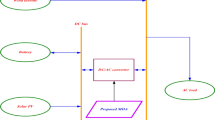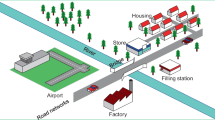Abstract
In this paper, the impact of rated power and the total capacity of all photovoltaic units on the energy loss reduction of radial distribution networks is investigated. An IEEE 69-node system is supposed to be a radial distribution network in the North and South of Vietnam to take the real mean solar radiations of 1 year from the global solar map for simulation. Five study cases are implemented corresponding to the difference of rated power of five installed photovoltaic units, including optimal size and four fixed sizes of 250, 500, 750 and 1000 kW. The proposed modified slime mould algorithm (MSMA) and three other algorithms including the original Coot optimization algorithm (COA), original Transient search optimization algorithm (TSOA) and original slime mould algorithm (SMA) are used to find optimal solutions of the five study cases. As a result, MSMA is the best method for reaching smaller 1-year energy loss and finding a higher number of more effective solutions than others. In addition, the study also suggests the placement of photovoltaic units should use optimal rated power for each unit and optimal total capacity for all units rather than using the same rated power for each unit and a predetermined total capacity for all units.






















Similar content being viewed by others
Abbreviations
- \(\Delta A_{{1{\text{year}}}}\) :
-
One-year energy loss
- \(N_{{{\text{line}}}}\) :
-
Number of contribution lines
- \(I_{l,h,m}^{{}}\) :
-
Current (in Ampere) on the lth line at the hth hour in the mth month of the year
- \(R_{l}\) :
-
Resistance (in Ω) of the lth line
- \(N_{\text{day},m}\) :
-
Number of days in the mth month of the year
- \( I_{l}^{\max }\) :
-
Maximum limit of the conductor of the lth line
- \(V^{{{\text{Min}}}}\), \(V^{{{\text{Max}}}}\) :
-
The lowest and highest operating voltage of loads
- \(N_{{{\text{node}}}}\) :
-
Node number in the considered distribution systems
- \(V_{n,h,m}\) :
-
Voltage of loads (in pu) at the nth node at the hth hour in the mth month
- \(P_{{\text{PV}}a,,h,m}\) :
-
Active power (in kW) generated by the ath PVU at the hth hour in the mth month
- \(P_{{\text{slack}},h,m}\), \(Q_{{\text{slack}},h,m}\) :
-
Active power and reactive power (in kW and kVAr) generated by power source at slack node at the hth hour in the mth month
- \(P_{{\text{Load}}n,h,m}\), \(Q_{{\text{Load}}n,h,m}\) :
-
Active and reactive power demand of load (in kW and kVAr) at the nth node at the hth hour in the mth month.
- \(N_\text{PV}\) :
-
Number of added PVUs
- \(X_{l}\) :
-
Reactance (in Ω) of the lth line
- \(N_{{{\text{po}}}}\) :
-
Size of population
- \(\text{FV}_{s}\) :
-
Fitness value of the sth being considered solution
- \(G_{{{\text{Max}}}} , \) G :
-
Maximum and current iteration
References
Zhu J (2015) Optimization of power system operation. John Wiley & Sons
Pham LH, Dinh BH, Nguyen TT, Phan VD (2021) Optimal operation of wind-hydrothermal systems considering certainty and uncertainty of wind. Alex Eng J 60:5431–5461. https://doi.org/10.1016/j.aej.2021.04.025
Ackermann T, Andersson G, Söder L (2001) Distributed generation: a definition. Electr Power Syst Res 57:195–204. https://doi.org/10.1016/S0378-7796(01)00101-8
Pepermans G, Driesen J, Haeseldonckx D et al (2005) Distributed generation: definition, benefits and issues. Energy Policy 33:787–798. https://doi.org/10.1016/j.enpol.2003.10.004
Truong KH, Nallagownden P, Elamvazuthi I, Vo DN (2020) An improved meta-heuristic method to maximize the penetration of distributed generation in radial distribution networks. Neural Comput Appl 32:10159–10181. https://doi.org/10.1007/s00521-019-04548-4
Duong MQ, Pham TD, Nguyen TT, Doan AT, Tran HV (2019) Determination of optimal location and sizing of solar photovoltaic distribution generation units in radial distribution systems. Energies 12(1):174. https://doi.org/10.3390/en12010174
Paliwal P, Patidar NP, Nema RK (2014) Planning of grid integrated distributed generators: a review of technology, objectives and techniques. Renew Sustain Energy Rev 40:557–570. https://doi.org/10.1016/j.rser.2014.07.200
Dixit M, Kundu P, Jariwala HR (2017) Incorporation of distributed generation and shunt capacitor in radial distribution system for techno-economic benefits. Eng Sci Technol Int J 20:482–493. https://doi.org/10.1016/j.jestch.2017.01.003
Li Y, Feng B, Li G et al (2018) Optimal distributed generation planning in active distribution networks considering integration of energy storage. Appl Energy 210:1073–1081. https://doi.org/10.1016/j.apenergy.2017.08.008
Kansal S, Kumar V, Tyagi B (2016) Hybrid approach for optimal placement of multiple DGs of multiple types in distribution networks. Int J Electr Power Energy Syst 75:226–235. https://doi.org/10.1016/j.ijepes.2015.09.002
Abul’Wwafa AR (2013) Optimal capacitor allocation in radial distribution systems for loss reduction: a two stage method. Electr Power Syst Res 95:168–174. https://doi.org/10.1016/j.epsr.2012.09.004
Viral R, Khatod DK (2015) An analytical approach for sizing and siting of DGs in balanced radial distribution networks for loss minimization. Int J Electr Power Energy Syst 67:191–201. https://doi.org/10.1016/j.ijepes.2014.11.017
Tamilselvan V, Jayabarathi T, Raghunathan T, Yang X-S (2018) Optimal capacitor placement in radial distribution systems using flower pollination algorithm. Alex Eng J 57:2775–2786. https://doi.org/10.1016/j.aej.2018.01.004
Ali ES, Abd Elazim SM, Abdelaziz AY (2016) Improved Harmony Algorithm for optimal locations and sizing of capacitors in radial distribution systems. Int J Electr Power Energy Syst 79:275–284. https://doi.org/10.1016/j.ijepes.2016.01.015
Khatod DK, Pant V, Sharma J (2013) Evolutionary programming based optimal placement of renewable distributed generators. IEEE Trans Power Syst 28:683–695. https://doi.org/10.1109/TPWRS.2012.2211044
Lee CS, Ayala HVH, dos Coelho LS (2015) Capacitor placement of distribution systems using particle swarm optimization approaches. Int J Electr Power Energy Syst 64:839–851. https://doi.org/10.1016/j.ijepes.2014.07.069
Devabalaji KR, Yuvaraj T, Ravi K (2018) An efficient method for solving the optimal sitting and sizing problem of capacitor banks based on cuckoo search algorithm. Ain Shams Eng J 9:589–597. https://doi.org/10.1016/j.asej.2016.04.005
Nguyen TT, Dinh BH, Pham TD, Nguyen TT (2020) Active power loss reduction for radial distribution systems by placing capacitors and PV systems with geography location constraints. Sustainability 12:7806. https://doi.org/10.3390/su12187806
Lata P, Vadhera S (2020) TLBO-based approach to optimally place and sizing of energy storage system for reliability enhancement of radial distribution system. Int Trans Electr Energy Syst 30:e12334. https://doi.org/10.1002/2050-7038.12334
Kien LC, Nguyen TT, Pham TD, Nguyen TT (2021) Cost reduction for energy loss and capacitor investment in radial distribution networks applying novel algorithms. Neural Comput Appl 33:15495–15522. https://doi.org/10.1007/s00521-021-06172-7
Tanwar SS, Khatod DK (2017) Techno-economic and environmental approach for optimal placement and sizing of renewable DGs in distribution system. Energy 127:52–67. https://doi.org/10.1016/j.energy.2017.02.172
Das CK, Bass O, Kothapalli G et al (2018) Optimal placement of distributed energy storage systems in distribution networks using artificial bee colony algorithm. Appl Energy 232:212–228. https://doi.org/10.1016/j.apenergy.2018.07.100
Sultana S, Roy PK (2014) Multi-objective quasi-oppositional teaching learning based optimization for optimal location of distributed generator in radial distribution systems. Int J Electr Power Energy Syst 63:534–545. https://doi.org/10.1016/j.ijepes.2014.06.031
Radosavljevic J, Arsic N, Milovanovic M, Ktena A (2020) Optimal placement and sizing of renewable distributed generation using hybrid metaheuristic algorithm. J Mod Power Syst Clean Energy 8:499–510. https://doi.org/10.35833/MPCE.2019.000259
Zhang Y, Ren S, Dong ZY et al (2017) Optimal placement of battery energy storage in distribution networks considering conservation voltage reduction and stochastic load composition. IET Gener Transm Distrib 11:3862–3870. https://doi.org/10.1049/iet-gtd.2017.0508
Arasteh A, Alemi P, Beiraghi M (2021) Optimal allocation of photovoltaic/wind energy system in distribution network using meta-heuristic algorithm. Appl Soft Comput 109:107594. https://doi.org/10.1016/j.asoc.2021.107594
Kassem Y, Camur H, Abughinda OAM (2020) Solar energy potential and feasibility study of a 10MW grid-connected solar plant in Libya. Eng Technol Appl Sci Res 10:5358–5366
Waqas U, Ahmed MF, Awan FG, Hussain Z (2021) A dimensionality reduction-based approach to select a suitable interpolator for the mapping of solar irradiation across Pakistan. Mapan 36:773–783
Matius ME, Ismail MA, Farm YY et al (2021) On the optimal tilt angle and orientation of an on-site solar photovoltaic energy generation system for Sabah’s rural electrification. Sustainability 13:5730. https://doi.org/10.3390/su13105730
Kitegi MSP, Lare Y, Coulibaly O (2022) Potential for green hydrogen production from Biomass, solar and wind in Togo. Smart Grid Renew Energy 13:17–27
Naruei I, Keynia F (2021) A new optimization method based on COOT bird natural life model. Expert Syst Appl 183:115352. https://doi.org/10.1016/j.eswa.2021.115352
Qais MH, Hasanien HM, Alghuwainem S (2020) Transient search optimization: a new meta-heuristic optimization algorithm. Appl Intell 50:3926–3941. https://doi.org/10.1007/s10489-020-01727-y
Li S, Chen H, Wang M et al (2020) Slime mould algorithm: a new method for stochastic optimization. Future Gener Comput Syst 111:300–323. https://doi.org/10.1016/j.future.2020.03.055
https://globalsolaratlas.info/detail?s=21.26667,106.13333,10&pv=medium,180,14,500
https://globalsolaratlas.info/detail?s=11.028084,106.700281,10&pv=medium,180,13,500
Acknowledgements
This work belongs to the project Grant Number T2023-33 funded by Ho Chi Minh City University of Technology and Education, Vietnam.
Author information
Authors and Affiliations
Corresponding author
Ethics declarations
Conflict of interest
The authors declare that they have no conflict of interest.
Additional information
Publisher's Note
Springer Nature remains neutral with regard to jurisdictional claims in published maps and institutional affiliations.
Rights and permissions
Springer Nature or its licensor (e.g. a society or other partner) holds exclusive rights to this article under a publishing agreement with the author(s) or other rightsholder(s); author self-archiving of the accepted manuscript version of this article is solely governed by the terms of such publishing agreement and applicable law.
About this article
Cite this article
Kien, L.C., Nguyen, T.T., Phan, T.M. et al. A study on the placement of photovoltaic units in the North and South of Vietnam for energy loss reduction by using a proposed slime mould algorithm. Neural Comput & Applic 35, 23225–23247 (2023). https://doi.org/10.1007/s00521-023-08982-3
Received:
Accepted:
Published:
Issue Date:
DOI: https://doi.org/10.1007/s00521-023-08982-3




